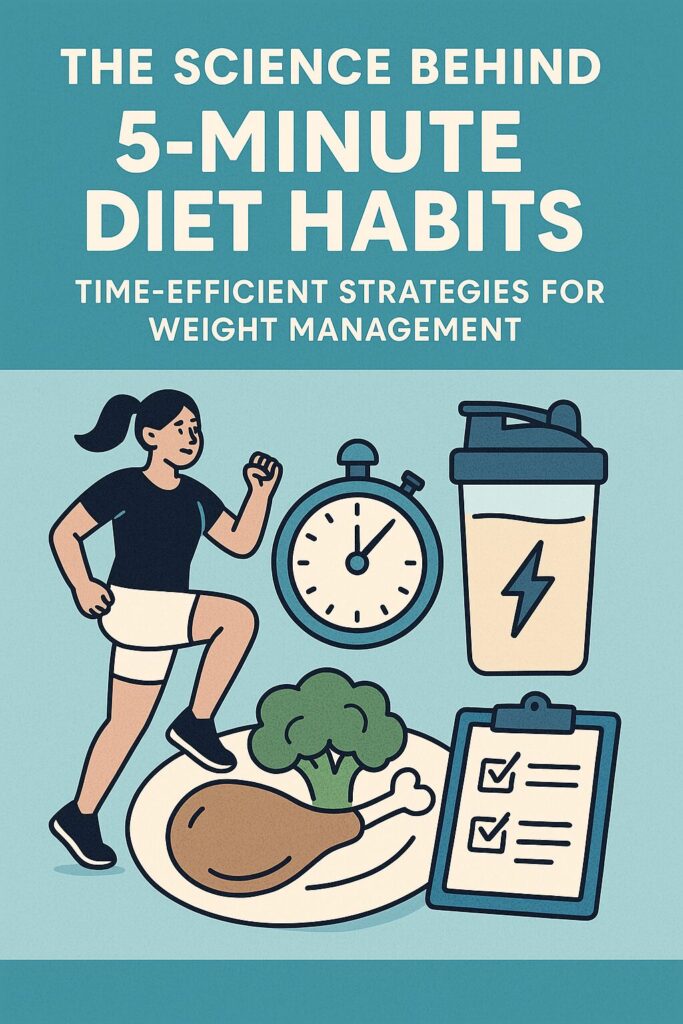
1. Introduction: The Modern Quest for Time-Efficient Weight Management
Modern life is often characterized by a relentless pace, leaving individuals struggling to balance professional responsibilities, family obligations, and personal well-being. In this context, adhering to traditional diet and exercise regimens, which often demand significant time and effort, can feel like an insurmountable challenge for many. The reality is that carving out an hour each day for a dedicated workout or meticulously preparing elaborate, time-consuming meals simply isn't feasible for a large segment of the population. This temporal constraint has fueled a growing interest in finding more efficient and manageable approaches to health and wellness, strategies that can be seamlessly integrated into the fabric of a busy daily routine.
Inspired by the user's query regarding "5-minute diet habits," this report delves into the scientific evidence supporting the potential of very short, time-efficient interventions for weight management. While the specific Japanese article prompting this inquiry remains inaccessible , the core concept of incorporating brief bursts of both physical activity and strategic dietary choices, particularly focusing on the role of protein, warrants a thorough examination based on available research. This exploration seeks to uncover the science behind these ultra-short habits and their effectiveness in achieving and maintaining a healthy weight.
In societies like Japan, there's a notable cultural emphasis on "タイパ" (taipa), a term that translates to "time performance" or efficiency in time utilization. This value extends to all aspects of life, including how individuals approach their health and wellness. The increasing appreciation for "タイパ" in the realm of self-care signifies a growing demand for solutions that are not only effective but also quick, easy to implement, and can be seamlessly woven into existing daily schedules. This societal trend underscores the potential relevance and appeal of "5-minute diet habits" for individuals seeking to optimize their time while prioritizing their health.
2. Unpacking the "5-Minute Diet": Exploring Short Bursts of Exercise
- The Science of Short-Duration, High-Intensity Exercise:
- High-Intensity Interval Training (HIIT): High-Intensity Interval Training, or HIIT, is an exercise protocol characterized by repeated short segments of intense activity interspersed with periods of rest or lower-intensity activity. The defining feature of HIIT is that the intense work intervals are performed at or near an individual's maximum capacity. These bursts of high-intensity effort can last anywhere from a brief 15 seconds to several minutes , and are followed by recovery periods that allow the body to briefly recuperate before the next intense interval. The strategic alternation between high-intensity work and recovery is what makes HIIT a time-efficient and potent method for improving fitness and overall health.
- Micro-Workouts: In contrast to longer, continuous exercise sessions, micro-workouts involve shorter, more frequent bouts of physical activity that are integrated throughout the day. These exercise sessions can be remarkably brief, with some studies suggesting that even a single minute of high-intensity exercise can yield measurable health benefits, particularly in terms of cardiovascular function and insulin sensitivity. Research has also demonstrated that the cumulative effect of engaging in multiple short bouts of exercise, even those lasting around 10 minutes, can be just as effective as a single, longer workout in achieving various health-related outcomes. This approach offers a high degree of flexibility, making it easier for individuals with packed schedules to incorporate physical activity into their daily lives without needing to dedicate large blocks of time.
- Benefits of HIIT and Micro-Workouts:
- Calorie Expenditure and Metabolic Boost: HIIT workouts have been shown to be exceptionally efficient at burning a significant number of calories in a relatively short amount of time. In fact, studies comparing HIIT to other popular forms of exercise, such as weight training, running, and cycling, have found that HIIT can lead to a 25-30% greater calorie burn within the same duration. A key advantage of HIIT is the "afterburn effect," scientifically known as Excess Post-Exercise Oxygen Consumption (EPOC). During the intense intervals of a HIIT workout, the body incurs an oxygen debt. In the recovery period following the workout, the body works to restore oxygen levels and repair muscles, resulting in a sustained elevation of the metabolic rate for several hours. This continued calorie burning and increased fat oxidation contribute significantly to weight management. Similarly, incorporating micro-workouts throughout the day can also help to boost metabolism, leading to a greater overall calorie expenditure.
- Cardiovascular Improvements: The high-intensity nature of HIIT workouts places considerable stress on the cardiovascular system, prompting it to adapt and improve. This adaptation leads to enhanced heart health, increased stroke volume (the amount of blood the heart pumps with each beat), and improved overall cardiovascular fitness. Research suggests that HIIT can be as effective as, or even more effective than, traditional steady-state cardiovascular exercises in eliciting these positive changes. Furthermore, emerging research on Vigorous Intermittent Lifestyle Physical Activity (VILPA) indicates that incorporating very short bursts of intense activity, lasting less than a minute each, into daily routines can significantly lower the risk of major adverse cardiovascular events (MACE), including heart attack and heart failure, particularly in women who do not engage in structured exercise.
- Potential Muscle Gain: HIIT workouts can effectively engage both fast-twitch and slow-twitch muscle fibers. The rapid, explosive movements characteristic of high-intensity intervals primarily activate the fast-twitch muscle fibers, which are responsible for generating power and strength. Additionally, the sustained effort and time under tension during HIIT can contribute to muscle hypertrophy (growth) and improved muscular endurance. Studies have indicated that HIIT may help to increase muscle mass in certain individuals, especially in the muscle groups that are most actively involved in the exercises, such as those in the trunk and legs. Similarly, engaging in micro-workouts throughout the day can also contribute to increasing muscular strength and endurance over time.
- Emerging Evidence on Vigorous Intermittent Lifestyle Physical Activity (VILPA): Vigorous Intermittent Lifestyle Physical Activity, or VILPA, is a relatively new concept that refers to brief, sporadic bouts of intense physical activity (typically lasting up to one to two minutes) that are seamlessly integrated into an individual's daily life, rather than being performed as part of a structured exercise routine. Examples of VILPA include activities like running to catch a bus, rapidly climbing stairs, carrying heavy shopping bags, or engaging in short bursts of power walking. Research published in the British Journal of Sports Medicine has revealed a significant association between VILPA and a substantially lower risk of major adverse cardiovascular events (MACE), myocardial infarction (heart attack), and heart failure, particularly among women who do not participate in regular, structured exercise. In fact, studies have shown that as little as 1.5 to 4 minutes of accumulated VILPA per day may be sufficient to confer these protective cardiovascular benefits. Furthermore, emerging evidence suggests that incorporating VILPA into daily routines is also associated with a reduced risk of developing cancer. Research indicates that approximately 4.5 minutes of VILPA per day, accumulated through short bursts lasting around one minute, may be linked to a notable reduction in overall cancer risk. The accessibility and ease of incorporating VILPA into everyday life make it a particularly promising strategy for improving public health, especially for individuals who find it challenging to adhere to traditional exercise recommendations. The stronger positive association observed between VILPA and cardiovascular health in women compared to men warrants further investigation to understand the underlying sex-specific physiological mechanisms that might contribute to this difference.
3. Practical Strategies for Integrating 5-Minute Workouts into a Busy Day
- Examples of Effective 5-Minute Exercises: For individuals seeking to incorporate short bursts of exercise into their busy schedules, a variety of effective 5-minute exercises can be readily implemented. For cardiovascular fitness, simple yet effective options include jumping jacks, high knees, and running in place, all of which can quickly elevate the heart rate. Burpees, a compound exercise combining a squat, push-up, and jump, provide a full-body workout and are excellent for cardiovascular conditioning. Strength training can also be effectively achieved in short durations using bodyweight exercises. Push-ups, whether performed against a desk, wall, or on the floor, target the chest, shoulders, and triceps. Squats, performed with just bodyweight or using a chair for support, are excellent for the lower body. Lunges work the legs and glutes, while planks and their variations are highly effective for strengthening the core muscles. Seated leg raises and standing calf raises can also be easily incorporated for targeted muscle activation. Tricep dips, using a chair or desk for support, provide a quick and effective way to work the back of the arms. For those interested in High-Intensity Interval Training (HIIT), any of the aforementioned exercises can be structured into short, intense intervals followed by brief rest periods. The Tabata protocol, a specific form of HIIT, involves performing an exercise at maximum intensity for 20 seconds followed by 10 seconds of rest, repeated for a total of eight rounds (4 minutes), offering a highly efficient way to maximize the benefits of a short workout.
- Tips and Techniques for Seamless Integration: Integrating these short exercise bursts into a busy day requires a degree of mindful planning and the adoption of simple techniques. Setting reminders on smartphones or computer calendars can serve as effective prompts to take short exercise breaks throughout the day. Combining physical activity with existing daily routines can also make exercise feel less like an added burden; for example, performing squats while brushing teeth or doing calf raises while waiting for the coffee to brew. Utilizing short breaks during work or other activities for a quick 5-minute workout can help break up prolonged periods of sitting and provide an immediate energy boost. Actively incorporating Vigorous Intermittent Lifestyle Physical Activity (VILPA) by consciously increasing the intensity of everyday activities, such as taking the stairs two at a time, carrying groceries with a faster pace, or engaging in short bursts of power walking, can contribute significantly to overall physical activity levels without requiring dedicated workout time. Embracing the concept of "exercise snacking," which involves breaking down the recommended amount of daily exercise into multiple shorter sessions (e.g., three 10-minute walks or several 5-minute bursts) throughout the day, can be a more manageable and less intimidating approach for individuals with limited time.
- The Role of Technology: Technology can play a supportive role in facilitating the integration of short workouts into daily life. Numerous fitness applications available for smartphones and smartwatches offer libraries of short workout routines specifically designed for various fitness levels and goals. These apps often include features such as progress tracking, workout scheduling, and notifications to help users stay motivated and consistent. Wearable devices with activity tracking capabilities can monitor daily movement, including steps taken and activity intensity, and some may even provide prompts or reminders to encourage users to engage in short bursts of activity, potentially including VILPA.
4. Fueling the "5-Minute Diet": The Importance of Protein and Strategic Nutrition
- The Crucial Role of Protein in Weight Management: Protein is a vital macronutrient that plays a multifaceted role in effective weight management. One of its primary benefits is its ability to significantly increase satiety and promote feelings of fullness after eating. This occurs because protein intake helps to reduce the levels of ghrelin, often referred to as the "hunger hormone," while simultaneously increasing the release of satiety-promoting hormones such as glucagon-like peptide-1 (GLP-1) and peptide YY (PYY). Furthermore, adequate protein consumption is essential for promoting the maintenance and growth of muscle mass, particularly when combined with regular exercise. Muscle tissue is metabolically active, playing a crucial role in regulating resting energy expenditure. Perhaps one of the most significant advantages of protein in the context of weight management is its high thermic effect of food (TEF) compared to carbohydrates and fats. This means that the body expends a greater number of calories during the digestion and metabolism of protein, contributing to a higher overall calorie expenditure. The hormonal mechanisms underlying protein-induced satiety involve complex signaling pathways within the gastrointestinal tract and the brain. While some studies suggest a direct correlation between protein intake and the release of specific satiety hormones , others indicate that the relationship is influenced by factors such as the overall caloric content of a meal and the specific context of eating. The "protein leverage theory" further proposes that the human body has a strong regulatory mechanism to ensure adequate protein intake, potentially influencing overall food consumption until protein needs are met.
- Understanding the Thermic Effect of Protein: The thermic effect of food (TEF) refers to the increase in energy expenditure that occurs after consuming food, as the body digests, absorbs, and metabolizes nutrients. Among the three macronutrients, protein exhibits the highest TEF, accounting for approximately 20-30% of the energy content of ingested protein being used for these processes. In comparison, carbohydrates have a TEF of around 5-15%, and fats have the lowest TEF, ranging from 0-5%. This significant difference in TEF suggests that choosing protein-rich foods can lead to a higher daily calorie expenditure compared to diets that are higher in fats or refined carbohydrates, even if the total number of calories consumed is the same. Thermic Effect of Food (TEF) for Macronutrients
| Macronutrient | Calories per Gram | TEF (Percentage of Energy Consumed) |
|---|---|---|
| Fat | 9 | 0-5% |
| Carbohydrate | 4 | 5-15% |
| Protein | 4 | 20-30% |
Google スプレッドシートにエクスポート
- Practical Ways to Increase Daily Protein Intake: Incorporating more protein into the daily diet can be achieved through several practical strategies. Starting the day with a protein-rich breakfast is a highly effective way to boost overall intake; options include eggs, Greek yogurt, protein smoothies, and cottage cheese. Aiming to include a source of protein with every meal and snack, rather than just focusing on larger meals, can help maintain a steady supply of amino acids and promote satiety throughout the day. Prioritizing the consumption of protein sources before other items on the plate can also help ensure adequate intake and promote earlier feelings of fullness. Keeping readily available protein-rich snacks on hand, such as nuts, seeds, jerky, cheese sticks, hard-boiled eggs, and edamame, provides convenient options for between-meal nourishment. Adding flavorless protein supplements like collagen peptides to beverages such as coffee or tea is another simple way to increase protein intake. Making simple swaps in everyday recipes, such as using quinoa instead of rice, Greek yogurt in place of sour cream, or incorporating protein powder into baked goods, can also contribute to a higher protein intake without drastically altering familiar meals.
- High-Protein, Low-Calorie Snack Options for Busy Individuals: For busy individuals seeking convenient and healthy snack options that are both high in protein and relatively low in calories, several excellent choices are available. These include Greek yogurt, cottage cheese, turkey sticks, a small portion of trail mix (emphasizing nuts and seeds over dried fruit and sugary additions), hard-boiled eggs, roasted edamame (young soybeans), canned tuna or salmon, lean beef or turkey jerky, and carefully selected low-calorie protein bars.
5. Balancing Intensity and Safety: Considerations for Short Workout Regimens
- The Importance of Warm-Up Routines: While the focus of "5-minute diet habits" might lean towards nutritional strategies, if short bursts of exercise are incorporated, even these brief sessions should ideally be preceded by a short warm-up to prepare the body for physical activity and minimize the risk of injury. Although general recommendations often suggest a warm-up of at least 10 minutes for a standard workout , for an ultra-short 5-minute routine, a more condensed warm-up of approximately 2-3 minutes focusing on dynamic stretches and light cardiovascular activity is advisable. Dynamic stretches involve movement and help to increase blood flow to the muscles and improve joint mobility, making them more suitable for pre-exercise preparation compared to static stretches, which involve holding a stretched position and may temporarily reduce muscle power. Examples of dynamic warm-up exercises suitable for short routines include arm circles, leg swings, torso twists, and marching in place. A proper warm-up helps to gradually increase blood flow to the working muscles, raise the body's core temperature, and enhance flexibility, thereby reducing the likelihood of muscle strains, pulls, and tears during the subsequent exercise. Skipping a warm-up, even for a brief workout, can increase the risk of injury, potentially lead to reduced performance, and contribute to post-exercise muscle soreness.
- Potential Risks of Long-Term Adherence to Very High-Protein Diets: While increasing protein intake can be a beneficial strategy for weight management, it is important to consider the potential risks associated with long-term adherence to very high-protein diets, even for individuals who are generally healthy. Some research suggests that excessive protein intake over extended periods may place increased strain on the kidneys, particularly for individuals who have pre-existing kidney conditions. Other potential concerns include the possibility of nutrient imbalances if the diet becomes overly focused on protein at the expense of other essential food groups, digestive issues such as constipation due to a lack of fiber often associated with high-protein diets, and in some instances, potentially adverse effects on mood and mental well-being. Interestingly, certain studies have indicated that in some populations, consuming very high levels of protein during weight loss might even hinder some of the metabolic benefits that are typically observed with a reduction in body weight. Therefore, while prioritizing protein intake is generally recommended for weight management, it is crucial to adopt a balanced dietary approach that includes adequate amounts of carbohydrates, healthy fats, and a variety of fruits and vegetables to ensure the intake of all necessary nutrients. Individuals with pre-existing health conditions, especially those related to kidney function, should consult with a healthcare professional or a registered dietitian before making significant changes to their protein intake.
6. Conclusion: Embracing Small, Sustainable Habits for Long-Term Well-being
The scientific evidence presented in this report underscores the potential of incorporating small, time-efficient habits into daily life for effective weight management and improved overall health. Short bursts of high-intensity exercise, including HIIT, VILPA, and micro-workouts, have been shown to be remarkably effective at increasing calorie expenditure, boosting metabolic rate, and enhancing cardiovascular health. Complementing these exercise strategies, a strategic focus on protein intake plays a vital role by promoting satiety, preserving lean muscle mass, and further enhancing metabolism through its significant thermic effect.
Ultimately, the key to achieving long-term success with these "5-minute diet habits" lies in embracing small, sustainable changes that can be seamlessly integrated into the demands of a busy lifestyle. Even brief increments of exercise and conscious efforts to increase protein intake can accumulate over time, leading to significant and lasting improvements in weight management and overall well-being. By prioritizing consistency and viewing these habits as integral components of daily routines, individuals can embark on a journey towards better health without the need for extensive time commitments or drastic lifestyle alterations.
立憲民主党「衰退」の理由を探る:最大野党の苦戦を読み解く
立憲民主党は2017年の結党以来、国政選挙で野党第一党の座を維持してきました。しかしその党勢は一進一退を繰り返し、近年では「衰退」とも形容される状況にあります。「衰退」とは何を指すのか? 議席数の減少、政党支持率の低迷、他党に押されて野党内での相対的地位が揺らぐことなどが挙げられます。かつて旧民主党として政権を担った流れを汲む立憲民主党が、なぜここまで苦戦しているのか――本稿では最新の選挙結果や各種分析をもとに、その理由を多角的に解説します。タイトルや各見出しにある「立憲民主党」「衰退」「支持率低下」とい ...
日中関係が崩壊し国交断絶したら何が起こるのか
高まるリスクと仮想シナリオの意義日中関係が万が一「崩壊」し、日本と中国が国交断絶に至った場合、どのような影響が生じるのでしょうか。そのような事態は現在起きていませんが、近年の米中対立の激化や台湾海峡の緊張などを背景に、日中関係の悪化シナリオは決して空想とは言い切れません。本記事では「日中関係が崩壊し国交断絶した場合に起こり得る影響」を多角的に分析します。仮想シナリオとして慎重に扱い、現時点では起きていない想定であること、不確実性が伴う予測であることをあらかじめ強調しておきます。また、特定の国家や民族への憎 ...
止まらない円安の行方:背景・影響・今後の展望
はじめに:2025年の「止まらない円安」をどう見るか 2025年現在、日本円の対外価値が大きく下落し、歴史的な円安水準が続いています。特に米ドルに対する円相場は1ドル=156円前後と約30年以上ぶりの安値圏にあり、ユーロなど他の主要通貨に対しても円は極端に弱い状況です。輸入品の値上がりや海外旅行の負担増など、円安の影響を日々実感している読者も多いでしょう。一方で、自動車など輸出企業の好調や訪日観光客の増加など、円安がもたらす恩恵も一部にはあります。 なぜ円安はこれほどまでに進行して止まらないのか? この状 ...
技能実習制度は2027年に廃止へ──新制度「育成就労制度」で何が変わるのか
日本の外国人技能実習制度が2027年までに廃止され、新たに「育成就労制度・在留資格『育成就労』」が導入されます。長年問題視されてきた技能実習制度の低賃金や人権侵害といった課題は、この新制度でどこまで改善されるのでしょうか。本記事では、技能実習制度の目的と実態、新制度創設の背景、育成就労制度の仕組みと特徴、そして期待される効果と残る懸念点を総合的に解説します。 外国人技能実習制度(以下、技能実習制度)が2027年4月1日までに廃止され、それに代わる新しい外国人受入制度「育成就労制度」が創設されることになりま ...
日中関係の悪化—現状と今後のシナリオ予測
2020年代半ば、アジア太平洋の秩序を揺るがす日中関係の緊張が高まっています。尖閣諸島周辺での中国公船の活動常態化や台湾海峡を巡る軍事的圧力、経済安全保障をめぐる制裁合戦など、両国間の摩擦は安全保障から経済、人的交流にまで及びます。日本にとって中国は最大の貿易相手国であり、また安全保障上も米中対立の焦点に位置するため、この関係悪化が与える影響は国家戦略から企業経営まで広範囲に及びます。本稿では2023~2025年の動向を踏まえ、今後12~24か月(~2027年初頭)の複数シナリオを定量・定性的に分析します ...





